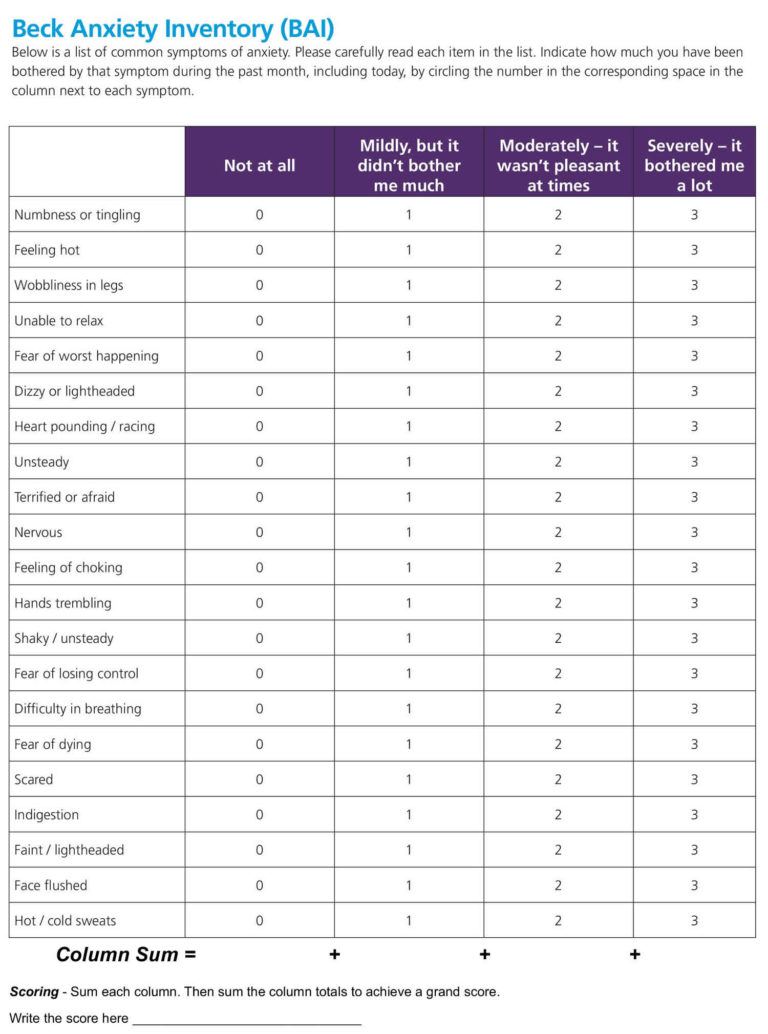

Every item in BAI is a brief description of an anxiety symptom in one of four expressed aspects:.Even though the age range of this test is 17 to 80 years, it has been used with younger adolescents of 12 years and older.The BAI can differentiate between anxiety and depression since the items in it explain the physiological, cognitive, and emotional symptoms of anxiety but not depression.The basic purpose of this inventory is to measure the severity of anxiety in adolescents and adults.The Beck Anxiety Inventory is a self-report inventory that consists of 21 multiple-choice items.Measure Profile: Beck Youth Inventories (BYI). Purchase the BYI manual, kit and/or booklets.

You can use the tables in Appendix A - Tables for Beck Youth Inventories (p.246) to convert raw scores into T-scores. Males 7-10 years old, 11-14 years old, 15-18 years old.Females 7-10 years old, 11-14 years old, 15-18 years old.

Raw scores are translated into T-scores assigned by age and gender:
Add scores from Items 81-100 for the total BDBI-Y score. Add scores from Items 61-80 for the total BANI-Y score. Add scores from Items 41-60 for the total BDI-Y score. Add scores from Items 21-40 for the total BAI-Y score. Add scores from Items 1-20 for the total BSCI-Y score. The BYI is a paper-pencil format so the child/young person can complete this on paper or it can be verbally administered if necessary. The BYI is available in English, Danish, French and Polish. The BYI is to be completed by children and young people aged 7-18 years old. The BYI demonstrates good discriminant validity, and has been found to reliably discriminate between internalising disorders, with the exception of depression (Measure Profile, 2012). The authors report evidence of good concurrent validity for each of the individual inventories (except the anger inventory) with measures of those constructs (e.g., the depression inventory with the Children’s Depression Inventory) (Measure Profile, 2012).Įxtent to which constructs that theoretically should not be highly related to each other are, in fact, not found to be highly correlated to each other. Test re-test reliability correlation coefficients have been found to range between 0.74 to 0.93 (Measure Profile, 2012).ĭegree to which a new measure and a previously validated measure of the same nature produce similar results. The BYI shows good to excellent internal consistency, with (alpha) coefficients ranging from 0.86 to 0.96 (Measure Profile, 2012).ĭegree to which the same respondents have the same score over a period of time, when the measured trait should not have changed. The extent to which a measure produces stable and consistent results. Children and young people describe how frequently a statement has been true for them over the past two weeks. The BYI is a 100-item self-report measure comprising five self-report inventories that can be used separately or in combination to assess symptoms of depression, anxiety, anger, disruptive behaviour, and self-concept.ġ) The Beck Depression Inventory for Youth (BDI-Y)Ģ) The Beck Anxiety Inventory for Youth (BAI-Y)ģ) The Beck Anger Inventory for Youth (BANI-Y)Ĥ) The Beck Disruptive Inventory for Youth (BDBI-Y)ĥ) The Beck Self-Concept Inventory for Youth (BSCI-Y).Įach inventory contains 20 questions about thoughts, feelings and behaviours associated with emotional and social impairment. Introduction to outcome measures - 14 June. Improving your Practice, using Outcome Measure tools - 19 September. Tailored support and resources for schools. Ready to register for Wellbeing Measurement for Schools?. Feedback and outcome measures for children and young people with learning disabilities. Questionnaires you can fill in electronically. Using outcome and experience measures remotely. CORC Research and Evaluation Consulting. Collecting and Improving the Quality of Mental Health Data.







 0 kommentar(er)
0 kommentar(er)
